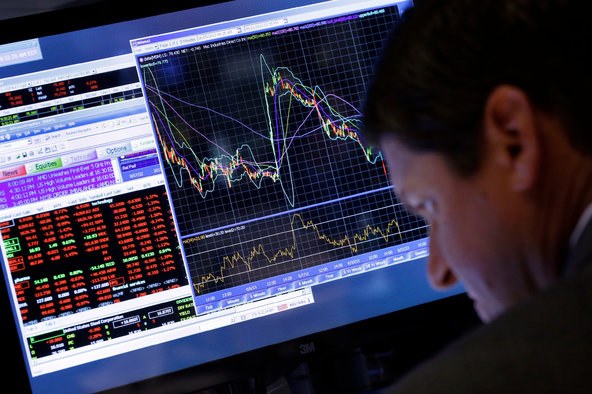Stocks on Wall Street edged higher on Thursday, putting equities on track for a third consecutive session of gains, as a flurry of economic data pointed to improving economic conditions.
Gains were limited, however, with many investors reluctant to make big bets going into Friday’s payroll report, and with the prospect of a Western-led strike against Syria still uncertain.
In afternoon trading, the Standard Poor’s 500-stock index was 0.2 percent higher, the Dow Jones industrial average also gained 0.2 percent and the Nasdaq composite was 0.3 percent higher.
While the data was positive, it did little to alter investor speculation about when the United States Federal Reserve might begin to ease its accommodative monetary policies, credited with spurring the equity market’s gains in 2013.
“Equities are stuck right now, and there won’t be conviction for buyers or sellers until we get more clarity,” said Todd M. Schoenberger, managing partner at LandColt Capital in New York.
The ADP National Employment Report showed that private employers added 176,000 jobs in August, nearly matching expectations for a gain of 180,000 jobs, while weekly initial jobless claims fell more than expected to a seasonally adjusted 323,000.
Separately, the Institute for Supply Management’s read on the services sector rose more than expected in August, while factory orders fell less than had been anticipated.
European shares ended the day higher, with the FTSEurofirst 300 index up 0.5 percent, and Asian markets closed mostly higher, helped by the Bank of Japan’s decision to continue its stimulus program.
In a positive sign of near-term upward momentum, the S. P. 500 closed above its 100-day moving average for the first time since Aug. 26 on Wednesday. It also closed above its 14-day moving average for the first time since Aug. 8.
After falling 3.1 percent in August, its worst monthly performance since May 2012, the S. P. 500 has kicked off September with a 1.5 percent advance thus far.
Market movement has recently been driven by the likelihood of a Western-led strike against Syria in retaliation for a possible chemical weapons attack against civilians; on Wednesday, the Senate Foreign Relations Committee backed a resolution supporting a strike.
Investors have been especially focused on any possible effect on oil supplies. Benchmark crude oil rose 0.8 percent, to $107.99 a barrel, extending its gains over the last two weeks.
“Until we have clear certainty on what will happen, it will be hard for the market to focus on anything but Syria for long,” Mr. Schoenberger said. “Will a war impact what the Fed does? Should we expect oil to go to $140? This is the big issue investors have.”
On Friday, the Labor Department will release its closely watched report on nonfarm payrolls for August.
“We’ve got a wait-and-see attitude ahead of the data, which isn’t surprising given the terrific day we had yesterday,” said Art Hogan, managing director at Lazard Capital Markets in New York. “While I’m not expecting any big moves ahead of tomorrow’s data, it is a positive that we’re not giving up any of our recent gains right now.”
The European Central Bank left its benchmark interest rate unchanged at a record low on Thursday, a decision that had been expected after recent economic indicators showed the euro zone economy was beginning to recover, albeit weakly.
Mario Draghi, the bank’s president, repeated that the central bank expected to keep its key rates “at present or lower levels” for an extended period, citing only “tentative signs” of economic improvement and a return of confidence in the euro zone.
Similarly, the Bank of England said it would keep its benchmark interest rate unchanged at a record low of 0.5 percent.
Ahead of the start of the Group of 20 summit meeting, Russia and China warned that an end to the Fed’s stimulus program could have a negative effect on the global economy.
The yield on a benchmark 10-year Treasury note was down slightly, to 2.94 percent. Analysts said the rout in Treasuries in recent months could persist.
Retail stocks will be in focus as many stores will report their August sales data. Costco Wholesale reported same-store sales that beat expectations despite lower fuel prices; its shares rose 2 percent.
Astex Pharmaceuticals rose 2.5 percent after Otsuka Pharmaceutical agreed to buy the company for $886 million.
Microsoft said late on Wednesday that a jury had decided in its favor in the second of two trials in federal court concerning Motorola Mobility’s licensing of so-called standard, essential patents used in Microsoft products. Shares of Microsoft, a component of the Dow average, were up 0.5 percent.
Boeing raised its 20-year outlook for the Chinese airplane market by 6 percent, citing growing demand for single-aisle and small, wide-body planes as travel in the Asia-Pacific region has surged. Its shares rose 0.2 percent.

Article source: http://www.nytimes.com/2013/09/06/business/daily-stock-market-activity.html?partner=rss&emc=rss



